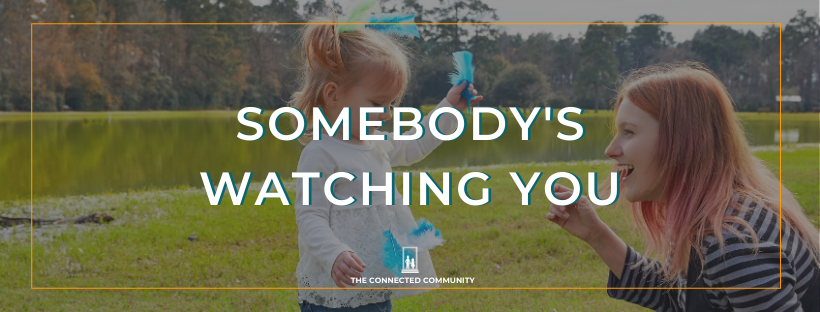Somebody's Watching You

? It always feels like somebody’s watching me ?
Parents, it probably does always feel like “Somebody’s Watching You” as the truth is, someone always is! Your children are watching and learning through behavior that you model- good, not so good, and everything in between. It always brings a smile to see a little one walking alongside their mom or dad, and you can see the physical movement, body position, often facial expression, and so on, matches pretty well what their parent or caregiver is ‘modeling’ through their physical movement, body position, facial expression, and so on. The closer the bond of the relationship, the more of this ‘matching’ behavior can be seen between two people.
Human beings have this fascinating part of their brains called mirror neurons. Mirror neurons are responsible for much of our learning and we can see these neurons at play with moms and new babies ‘matching’ their behaviors in a kind of synchronized dance. They imitate each other’s eye contact, body movement, posture, and even sleep cycles increasingly over time. These behaviors that take place naturally in attentive and attuned caregiving, build secure attachment from which a child is able to more readily learn, grow, and interact in the world. The safety the child feels in this kind of connected relationship is key to a person who can later function in the social world without fear- fear of being hurt, abandoned, or shamed into being anything less than who they truly are. The ability to be authentically themselves then sets a healthy foundation for being able to connect with others and fully engage in their world.
We can intentionally help children to improve or enhance learning and increase connection. We can engage in ‘matching’ behavior on purpose – like sitting down on the floor beside our child, sitting cross-legged if that’s how they are sitting, or sitting back resting on our hands if that matches what the child is doing. We can look at the book that they are looking at and wear an expression on our face that matches theirs, and softly gaze into their eyes to build a deeper connection. When we do these things, our child knows we ‘see them,’ we ‘get them,’ and we truly want to understand what they are thinking and feeling- we want deep, meaningful, powerful connection.
However, for children that come from ‘hard places’ such as those who have experienced abuse or trauma, it may not feel safe to them if a caregiver immediately gets down on their level, establishes direct eye contact, and interacts in a way to attempt to build connection. In fact, they may find this well-meaning behavior of attempting to tune-in to them on a deeply connected level, kind of scary based on painful past experiences they may have had.
But it is important to gently begin to build a relationship through gradual, playful, increasingly connecting kinds of interactions. A child from an abusive background may need us to sit beside them and subtly match the position they are holding their body; they may allow for us to gradually look at a book they are looking at, with brief glances, and maybe quietly kind of noticing out loud what we’re seeing. If there is a little glimpse of eye contact- appreciate that, and savor moments where the eye contact might linger just a little longer. This gradual teeny-tiny “baby-step” type of progression may be just what a child from a ‘hard place’ needs to feel increasingly safe, increasingly more trusting and ultimately, increasingly connected and attached to their new caregiver.
Activity: Feather Match
Have two sets of five feathers, (or stickers or ‘jewelry’ you and your child have made with play dough) ready for this ‘matching’ activity. Whatever you are using, make sure the two sets match. Sit wherever, and however, is comfortable for you and your child- if your child can tolerate it facing each other would work best. If not, sitting beside one another can work. Now, ‘decorate’ your child with one feather (in her hair, on her pant leg, on her sleeve, between her fingers, behind her ear-be creative and playful!). Your child then places a matching feather (or whatever item you are using) on you in the same place. Carry on with the next feather, you decorate them, then they decorate you in the same place, and so on until you’re both all decorated! Now admire each other and your beautiful newly decorated selves!
Written by Deb Levenseller, Clinical Director at The Maine Children's Home for The Connected Community @ MCH.